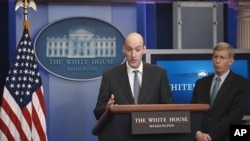As Japan continues to battle a worsening crisis at the damaged Fukushima nuclear power plant, U.S. nuclear officials are responding to President Barack Obama's call to ensure that nuclear power plants across the United States are safe.
Nuclear energy was making a come back in the United States as fears faded of the 1979 Three Mile Island nuclear power plant accident. President Obama's 2012 budget proposal included $36 billion in loan guarantees for building nuclear power plants.
But Americans were reminded of the dangers last week, when an earthquake and tsunami set off a chain of uncontrollable events at the Fukushima plant in Japan. Images of explosions, fires and smoke plumes filled American televisions, triggering questions about the safety of nuclear power plants at home.
The U.S. Nuclear Regulatory Commission announced Thursday it will launch a comprehensive safety review of the 104 nuclear power plants across the United States, at the request of Mr. Obama.
NRC chairman Gregory Jaczko told reporters the U.S. will learn from Japan."We're going to take a look at what happened, we're going to do a systematic and a methodical review of the information, and if we need to make changes to our program, we'll makes changes to our program," he said.
Nuclear expert Peter Bradford on Friday predicted the nuclear industry would hit a slow down. "The NRC can't divert the resources that it's going to have to the lessons learned process and still continue to crank out design approval and construction and operating licenses on the original schedule," he said.
Bradford, a former member of the U.S. Nuclear Regulatory commission, said it could take 12 to 24 months for an evaluation of the nuclear crisis in Japan to be complete. He says only then will the lessons be learned.
Robert Alvarez, a senior scholar at the Institute for Policy Studies, expressed concern about some U.S. nuclear power plants. "We should, at this time, put on the brakes, with respect to some of the operating reactors. There are operating reactors in earthquake zones that have experienced very destructive earthquakes in the past, many of which are seeking to extend their operating licenses," he said.
He also discussed a 2004 National Academy of Sciences report that revealed overcapacity problems with spent fuel pools -- which hold used fuel rods in deep water for cooling and to prevent them from emitting radiation. "In the United States, the spent fuel pools are currently holding four times more than their designs intended. They are densely compacted," he said.
In Japan, spent fuel pools are dominating the attention of emergency workers. The water temperature is two times what it should be in two of the six pools, while spent fuel rods in another pool is believed to be exposed to air and emitting radioactive gases.
A report released by the Union of Concerned Scientists on Thursday said the NRC has "tolerated known safety problems" leading to troubling events, safety equipment problems and security shortcomings at nuclear power plants across the United States.
But Nuclear Regulatory Commission chairman Jaczko assured the public that U.S. nuclear power plants, located in 31 U.S. states, undergo regular safety inspections."I want to emphasize and stress that we have a very robust program where we look at the safety and the security of our nuclear facilities on a minute-by-minute basis," he said.
On Wednesday, U.S. Secretary of Energy Steven Chu said the Obama administration continues to support the expansion of nuclear power in the United States, despite the crisis in Japan.









